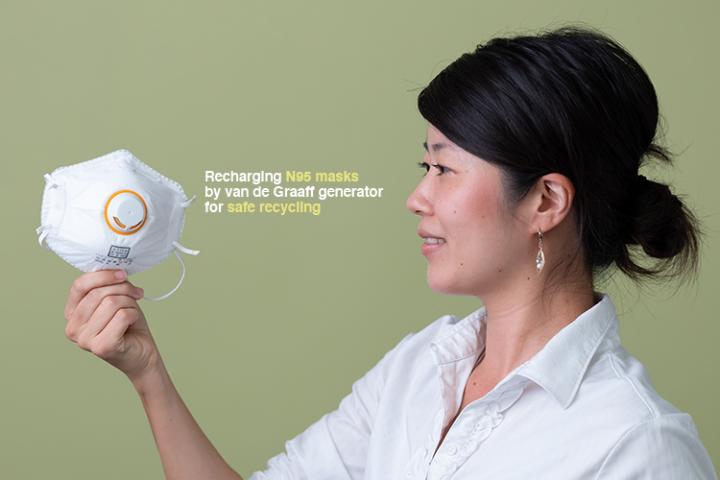
Credit: Institute of Industrial Science, the University of Tokyo
Tokyo, Japan – A researcher from the Institute of Industrial Science at The University of Tokyo has demonstrated a novel method for recharging sterilized N95 masks so that they can be reused. By exposing the masks to 100 kilovolts for 3 minutes after sterilization in hot water or an autoclave, they regained their static charge. This work can be rapidly applied to help meet the huge demand for protective equipment that can prevent the spread of the COVID virus.
During the current COVID pandemic, N95 masks have been indispensable for keeping health care workers and first responders safe. The name comes from the fact that these masks can filter more than 95% of airborne particles, even though they have pore sizes ten times larger than the small aerosol particles that can carry the virus. The trick is that the N95 masks are made of electrospun polypropylene fibers, which retain a static electric charge that can attract and trap the charged aerosols. However, this static charge cannot withstand normal sterilization procedures, such as washing in hot water or autoclaving. Even the moisture in the wearer’s breath can degrade the effectiveness of the electric attraction. For this reason, the masks are often discarded after a single use, which greatly increases the gap between the number of N95 masks needed and the number available.
Now, a researcher at The University of Tokyo has shown that sterilized masks can be returned to use after being recharged using a van de Graaff generator. These devices, familiar to many science museum visitors, use the friction from a spinning belt to generate very high voltages between two metal conductors. “Making use of the high voltage provided by the van de Graaff generator, this method is much faster than alternative methods,” study author Kaori Sugihara says. To regenerate a mask that had been previously sterilized, it was attached to the larger metallic sphere, while the smaller sphere was placed several centimeters away for 3 minutes. The regenerated masks were tested and shown to be comparable in filtering ability to unused masks.
“Hopefully, this method will allow many more people to have access to N95 masks each day, which is our best line of defense against COVID transmission,” Sugihara says. Because van de Graaff generators are much cheaper and safer to use than other high voltage sources, this method can be implemented easily in hospitals and other locations where N95 masks are most needed. The work is published in Soft Matter as “Recharging N95 masks by van de Graaff generator for safe recycling.”
###
About Institute of Industrial Science (IIS), the University of Tokyo Institute of Industrial Science (IIS), the University of Tokyo is one of the largest university-attached research institutes in Japan.
More than 120 research laboratories, each headed by a faculty member, comprise IIS, with more than 1,000 members including approximately 300 staff and 700 students actively engaged in education and research. Our activities cover almost all the areas of engineering disciplines. Since its foundation in 1949, IIS has worked to bridge the huge gaps that exist between academic disciplines and realworld applications.
Media Contact
Kaori Sugihara
[email protected]
Original Source
https:/
Related Journal Article
http://dx.




